If your web browser constantly opens to unwanted Gstatic pages, then it is possible that Adware (sometimes called ‘ad-supported’ software) get installed on your personal computer. Adware can modify your web-browser’s settings or install an unwanted browser extension so that it’ll display a large amount of pop ups, ads and deals. If you would like to free your computer of ad supported software and thereby remove Gstatic pop-ups and are unable to do so, you can use the instructions below to search for and remove this ‘ad supported’ software and any other malware for free.
The ad supported software which causes Gstatic redirects, is not a virus, but the virus behaves similarly. As a rootkit hides in the system, modifies internet browser settings and blocks them from changing. Also the ‘ad supported’ software may install web browser hijacker that once started, will change the browser’s home page and search provider.
Even worse, the adware be able to collect a wide variety of user data such as what sites you are opening, what you are looking for the Internet and so on. This confidential info, afterwards, may be sold to third parties.
We strongly recommend that you perform the tutorial below which will allow you to remove Gstatic redirect using the standard features of Windows and some proven free programs.
How to remove Gstatic (removal guide)
Not all undesired software such as adware that causes a lot of unwanted Gstatic pop-up ads are easily uninstallable. You might see popups, deals, text links, in-text ads, banners and other type of advertisements in the Chrome, Firefox, Edge and Internet Explorer and might not be able to figure out the application responsible for this activity. The reason for this is that many undesired software neither appear in Windows Control Panel. Therefore in order to completely remove Gstatic ads, you need to complete the following steps. Read it once, after doing so, please print this page as you may need to shut down your browser or restart your personal computer.
To remove Gstatic, use the following steps:
- Manual Gstatic redirect removal
- Gstatic redirect automatic removal
- Use AdBlocker to stop Gstatic redirect
- How was adware installed on machine
- To sum up
Manual Gstatic redirect removal
If you perform exactly the instructions below you should be able to delete the Gstatic pop-ups from the Internet Explorer, Edge, Google Chrome and Mozilla Firefox internet browsers.
Remove suspicious software by using Microsoft Windows Control Panel
Some of PUPs, ad-supported software and hijackers can be removed using the Add/Remove programs utility which can be found in the Microsoft Windows Control Panel. So, if you’re running any version of Windows and you have noticed an unwanted program, then first try to get rid of it through Add/Remove programs.
Windows 8, 8.1, 10
First, click Windows button

Once the ‘Control Panel’ opens, click the ‘Uninstall a program’ link under Programs category as shown in the figure below.

You will see the ‘Uninstall a program’ panel as displayed on the image below.

Very carefully look around the entire list of apps installed on your computer. Most probably, one of them is the ‘ad supported’ software that causes a large amount of undesired Gstatic popups and redirects. If you’ve many applications installed, you can help simplify the search of harmful apps by sort the list by date of installation. Once you’ve found a questionable, unwanted or unused application, right click to it, after that click ‘Uninstall’.
Windows XP, Vista, 7
First, click ‘Start’ button and select ‘Control Panel’ at right panel as displayed below.

After the Windows ‘Control Panel’ opens, you need to press ‘Uninstall a program’ under ‘Programs’ as shown in the figure below.

You will see a list of software installed on your machine. We recommend to sort the list by date of installation to quickly find the software that were installed last. Most probably, it’s the ad-supported software which causes unwanted Gstatic pop up advertisements. If you’re in doubt, you can always check the program by doing a search for her name in Google, Yahoo or Bing. After the program which you need to delete is found, simply click on its name, and then click ‘Uninstall’ like below.

Remove Gstatic from Chrome
Reset Google Chrome settings will remove Gstatic redirect from web-browser and disable malicious extensions. It will also clear cached and temporary data (cookies, site data and content). However, your saved passwords and bookmarks will not be changed, deleted or cleared.
Open the Chrome menu by clicking on the button in the form of three horizontal dotes (![]() ). It will display the drop-down menu. Select More Tools, then press Extensions.
). It will display the drop-down menu. Select More Tools, then press Extensions.
Carefully browse through the list of installed extensions. If the list has the plugin labeled with “Installed by enterprise policy” or “Installed by your administrator”, then complete the following tutorial: Remove Google Chrome extensions installed by enterprise policy otherwise, just go to the step below.
Open the Google Chrome main menu again, press to “Settings” option.

Scroll down to the bottom of the page and click on the “Advanced” link. Now scroll down until the Reset settings section is visible, as on the image below and press the “Reset settings to their original defaults” button.

Confirm your action, click the “Reset” button.
Remove Gstatic popups from Internet Explorer
By resetting Internet Explorer web browser you restore your web-browser settings to its default state. This is first when troubleshooting problems that might have been caused by adware responsible for redirecting your browser to Gstatic page.
First, launch the Microsoft Internet Explorer, then click ‘gear’ icon ![]() . It will display the Tools drop-down menu on the right part of the internet browser, then press the “Internet Options” as displayed below.
. It will display the Tools drop-down menu on the right part of the internet browser, then press the “Internet Options” as displayed below.

In the “Internet Options” screen, select the “Advanced” tab, then click the “Reset” button. The Microsoft Internet Explorer will open the “Reset Internet Explorer settings” dialog box. Further, press the “Delete personal settings” check box to select it. Next, click the “Reset” button as displayed below.

When the procedure is done, click “Close” button. Close the IE and reboot your PC system for the changes to take effect. This step will help you to restore your web browser’s default search provider, newtab and startpage to default state.
Delete Gstatic popup ads from Mozilla Firefox
If the Firefox web-browser is redirected to Gstatic and you want to recover the Firefox settings back to their default state, then you should follow the steps below. However, your themes, bookmarks, history, passwords, and web form auto-fill information will not be deleted.
Run the Firefox and press the menu button (it looks like three stacked lines) at the top right of the web-browser screen. Next, click the question-mark icon at the bottom of the drop-down menu. It will show the slide-out menu.

Select the “Troubleshooting information”. If you are unable to access the Help menu, then type “about:support” in your address bar and press Enter. It bring up the “Troubleshooting Information” page as on the image below.

Click the “Refresh Firefox” button at the top right of the Troubleshooting Information page. Select “Refresh Firefox” in the confirmation prompt. The Firefox will begin a process to fix your problems that caused by the adware that responsible for the appearance of Gstatic popup ads. After, it is complete, click the “Finish” button.
Gstatic redirect automatic removal
The easiest solution to remove Gstatic redirect is to use an anti-malware application capable of detecting this adware which made to redirect your internet browser to various ad websites like Gstatic. We recommend try Zemana AntiMalware (ZAM) or another free malicious software remover that listed below. It has excellent detection rate when it comes to ‘ad supported’ software, hijackers and other potentially unwanted programs.
Scan and free your browser of Gstatic pop-ups with Zemana Anti-malware
We recommend using the Zemana Anti-malware. You may download and install Zemana Anti-malware to scan for and remove Gstatic pop-up advertisements from the Firefox, IE, MS Edge and Chrome browsers. When installed and updated, the malicious software remover will automatically check and detect all threats present on your computer.

- Please go to the link below to download the latest version of Zemana for Microsoft Windows. Save it to your Desktop.
Zemana AntiMalware
164807 downloads
Author: Zemana Ltd
Category: Security tools
Update: July 16, 2019
- Once the download is done, close all applications and windows on your computer. Open a folder in which you saved it. Double-click on the icon that’s named Zemana.AntiMalware.Setup.
- Further, click Next button and follow the prompts.
- Once installation is finished, click the “Scan” button to begin checking your PC for the ad supported software that made to redirect your web browser to Gstatic pages. During the scan Zemana Free will detect threats present on your system.
- Once the system scan is done, Zemana Free will show you the results. All detected threats will be marked. You can delete them all by simply click “Next”. When the process is done, you can be prompted to restart your system.
Scan and free your PC of ‘ad supported’ software with HitmanPro
Hitman Pro will help get rid of ad-supported software, which redirects your web-browser to Gstatic pages, that slow down your personal computer. The browser hijacker infections, ad supported software and other PUPs slow your web-browser down and try to force you into clicking on dubious advertisements and links. HitmanPro removes the ad supported software and lets you enjoy your personal computer without Gstatic popups.
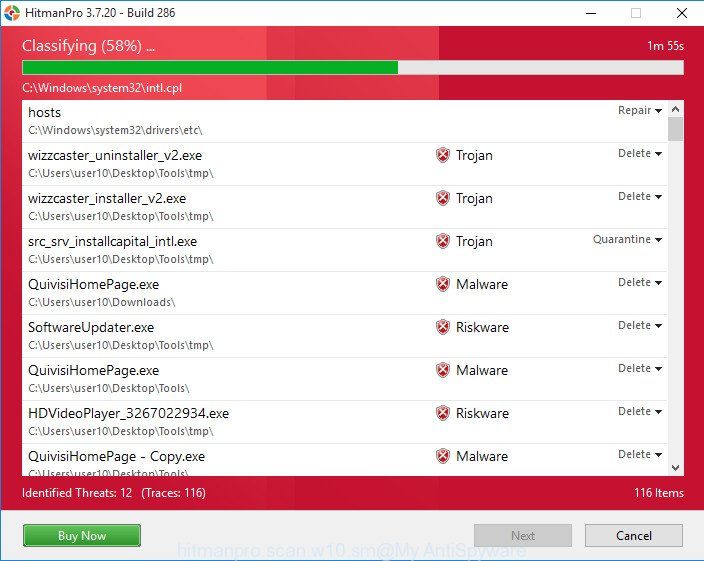
- Visit the page linked below to download Hitman Pro. Save it to your Desktop so that you can access the file easily.
- Once the downloading process is done, start the HitmanPro, double-click the HitmanPro.exe file.
- If the “User Account Control” prompts, click Yes to continue.
- In the Hitman Pro window, press the “Next” to find out adware which causes unwanted Gstatic redirects. A scan can take anywhere from 10 to 30 minutes, depending on the number of files on your PC system and the speed of your machine. While the Hitman Pro utility is checking, you can see how many objects it has identified as being affected by malicious software.
- After the scan is finished, Hitman Pro will display a list of all threats found by the scan. You may delete items (move to Quarantine) by simply click “Next”. Now, click the “Activate free license” button to begin the free 30 days trial to remove all malware found.
How to get rid of Gstatic with Malwarebytes
You can remove Gstatic pop ups automatically with a help of Malwarebytes Free. We recommend this free malicious software removal utility because it can easily delete browser hijacker infections, adware, potentially unwanted applications and toolbars with all their components such as files, folders and registry entries.
Visit the following page to download the latest version of MalwareBytes for Microsoft Windows. Save it on your MS Windows desktop.
327063 downloads
Author: Malwarebytes
Category: Security tools
Update: April 15, 2020
After the download is finished, close all apps and windows on your PC. Double-click the install file named mb3-setup. If the “User Account Control” dialog box pops up as displayed in the following example, click the “Yes” button.
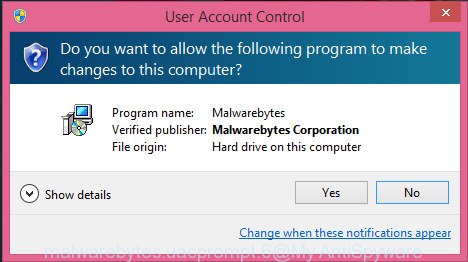
It will open the “Setup wizard” that will help you install MalwareBytes on your personal computer. Follow the prompts and don’t make any changes to default settings.
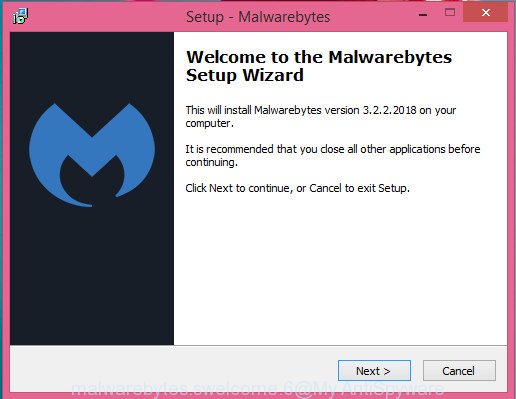
Once setup is done successfully, press Finish button. MalwareBytes Anti Malware will automatically start and you can see its main screen as displayed on the screen below.
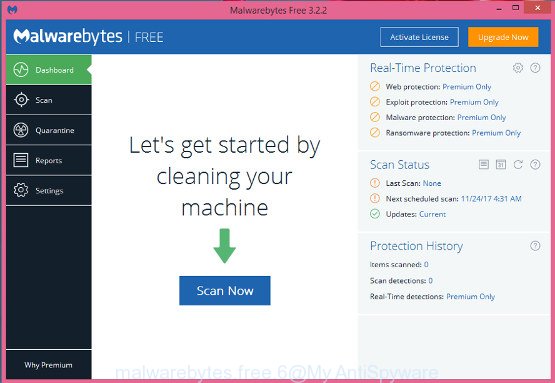
Now click the “Scan Now” button to perform a system scan with this tool for the ‘ad supported’ software that responsible for the appearance of Gstatic redirect. Depending on your personal computer, the scan can take anywhere from a few minutes to close to an hour. While the MalwareBytes Anti-Malware (MBAM) tool is checking, you can see how many objects it has identified as being affected by malware.
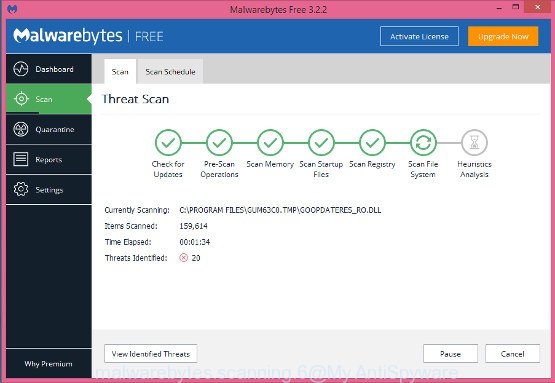
When the scan get finished, MalwareBytes AntiMalware (MBAM) will open a screen that contains a list of malware that has been found. Review the results once the utility has complete the system scan. If you think an entry should not be quarantined, then uncheck it. Otherwise, simply press “Quarantine Selected” button. The MalwareBytes Anti Malware (MBAM) will delete adware that causes multiple intrusive pop ups and add threats to the Quarantine. When disinfection is finished, you may be prompted to reboot the PC.
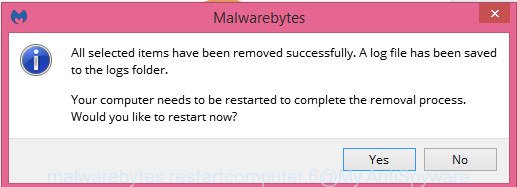
We recommend you look at the following video, which completely explains the process of using the MalwareBytes Free to remove ‘ad supported’ software, hijacker and other malware.
Use AdBlocker to stop Gstatic redirect
To put it simply, you need to use an adblocker tool (AdGuard, for example). It’ll block and protect you from Gstatic redirects, advertisements and pop-ups. To be able to do that, the adblocker program uses a list of filters. Each filter is a rule that describes a malicious web-page, an advertising content, a banner and others. The ad-blocking program automatically uses these filters, depending on the pages you’re visiting.
- Visit the following page to download the latest version of AdGuard for Microsoft Windows. Save it on your Desktop.
Adguard download
26841 downloads
Version: 6.4
Author: © Adguard
Category: Security tools
Update: November 15, 2018
- After downloading is finished, run the downloaded file. You will see the “Setup Wizard” program window. Follow the prompts.
- Once the installation is finished, press “Skip” to close the installation program and use the default settings, or click “Get Started” to see an quick tutorial which will allow you get to know AdGuard better.
- In most cases, the default settings are enough and you don’t need to change anything. Each time, when you start your system, AdGuard will launch automatically and block unwanted advertisements, Gstatic redirect, as well as other harmful or misleading websites. For an overview of all the features of the program, or to change its settings you can simply double-click on the icon called AdGuard, which is located on your desktop.
How was adware installed on machine
These days some free programs creators bundle third-party software which could be PUPs such as this ad-supported software, with a view to making some money. These are not freeware as install an unwanted applications on to your Microsoft Windows computer. So whenever you install a new free program that downloaded from the Web, be very careful during installation. Carefully read the EULA (a text with I ACCEPT/I DECLINE button), select custom or manual setup type, reject all additional programs.
To sum up
Once you’ve done the few simple steps outlined above, your system should be clean from adware which designed to reroute your web-browser to Gstatic pages and other malware. The Microsoft Edge, Firefox, Chrome and Internet Explorer will no longer redirect you to unwanted webpages. Unfortunately, if the guide does not help you, then you have caught a new ad-supported software, and then the best way – ask for help here.


















